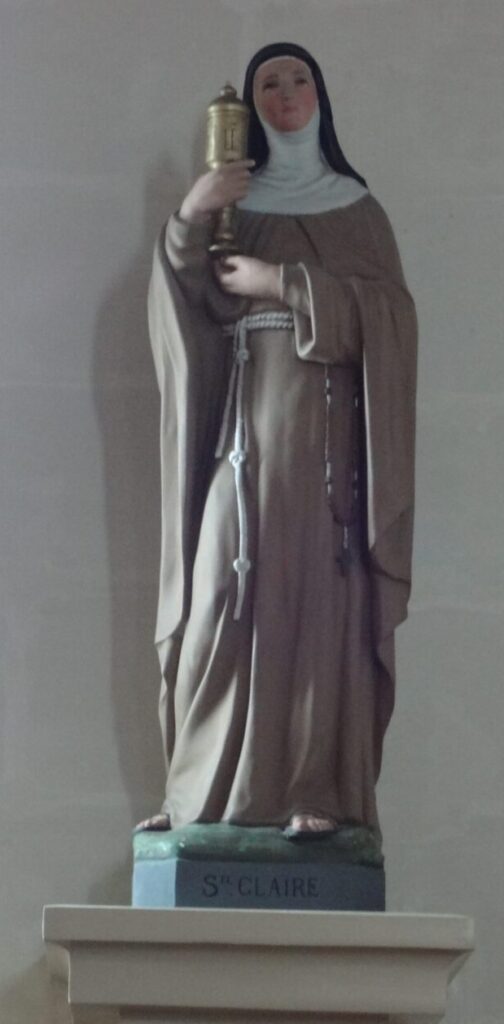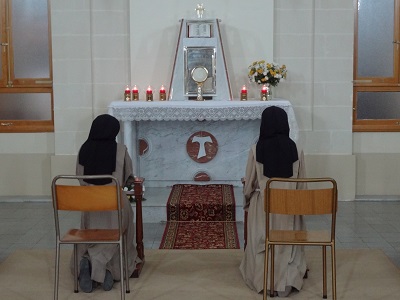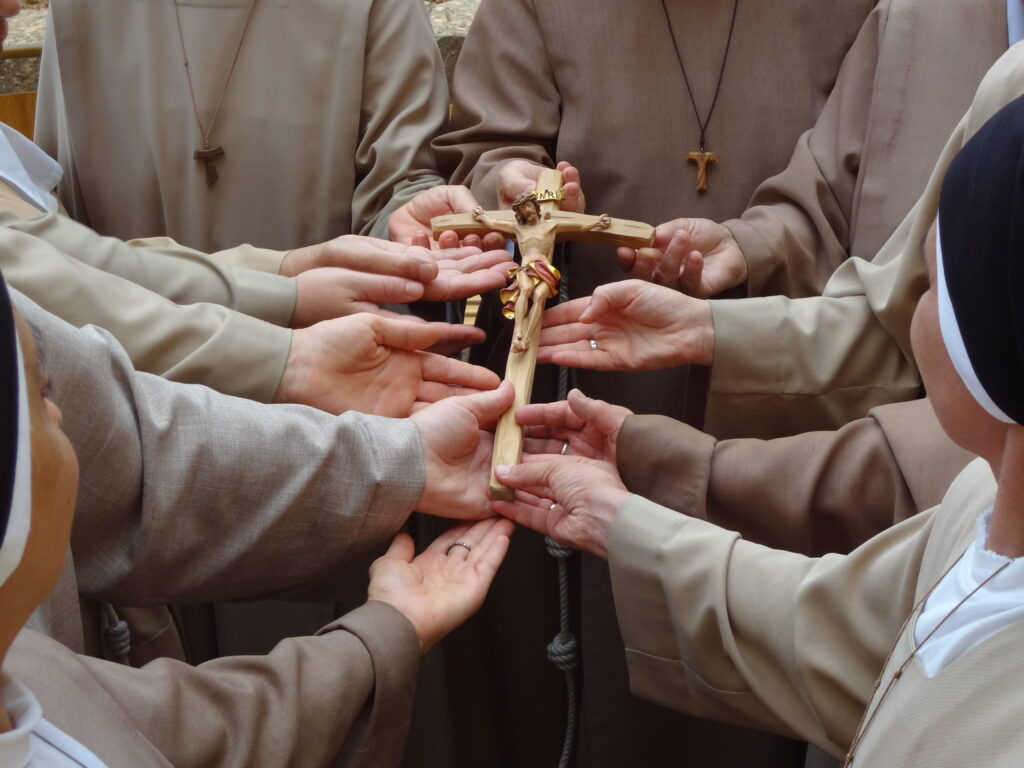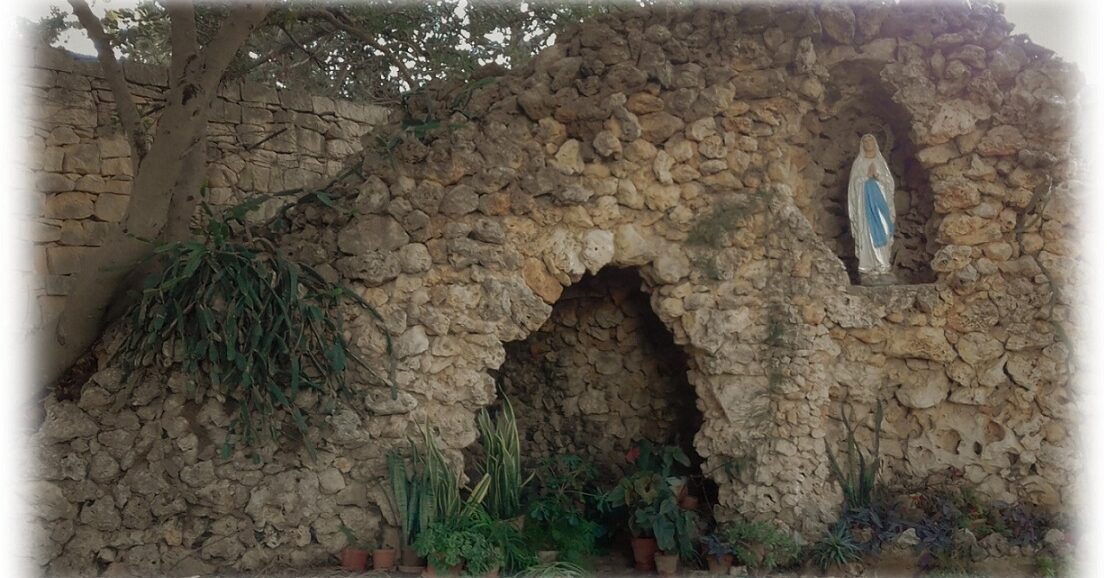
As Poor Clares we follow the Rule handed down to us by the foundress of our Order St. Clare of Assisi.
St. Clare was a contemporary of St. Francis of Assisi with a twelve-year difference between them. They lived during the Middle Ages at a time when the Pope was more like a monarch than a Shepherd and guided the Church as such, but he was also a man of God and when these two Saints, especially Francis, wanted to live a life following the Poor Crucified in his poverty, the Pope immediately understood that before him stood a little man who had the calling of lifting up the Church and put it back on its axis, and therefore, against all the misgivings of those surrounding him, like the Cardinals and the other Princes of the Church, he gave Francis his blessing to live the Gospel sine glossa, that is, without any gloss and interpretations. This is the life that our Foundress Clare was also inspired by the Holy Spirit to live – a life following the Poor Crucified in his footsteps of poverty. But unlike Francis she could not live on the streets, but in the cloister, which was the only other choice she had. This is because at that time a woman had only two choices in life – and these were decided by her family – either get married or become a nun.
On Palm Sunday, when she was only 18 years old, Clare decided to run away from the house of her noble family because she knew of the opposition that her family would make if she told them that she wanted to live like the ‘Poverello’ of their town who was considered crazy by the rich and noble people of Assisi. So in the middle of the night she ran away from a beautiful home and all the securities that a noble girl enjoyed and had a right to, through a back door, and ran to the Porziuncola, where Francis and his friars were waiting for her, chanting the psalms and other prayers for her. Francis gave her the tonsure, that is, he cut her hair a sign of her consecration to God and she promised him, Francis, obedience to live according to his way of life. Francis took her, that night, to the Benedictine Nuns, not far away from the Porziuncola. Clare presented herself to these nuns as a ‘converse’, that is, as one who was poor and not as a noble woman. The ‘converse’ nuns did all the labor work in the monastery while those coming from noble families did not. But even so, Clare knew that the Benedictine’s way of life was not what The Holy Spirit was inspiring her to live even if she lived there as a converse nun, so Francis tooke her to another place, San Paolo De Panzo, before moving her finally and definitively at San Damiano where she lived for the next fourty years of her life with an ever increasing number of other nuns. Our Foundress died in 1253 when she was 60 years old. She lived for 42 years in San Damiano where she defended the Franciscan ideal with her whole being sometimes even agains those most close to her, like the Bishop of Assisi who later became Pope Gregory IX. St. Clare is also the only woman ever to have written a Rule and although it is almost a copy of what St. Francis wrote to his brethren with regards to living the way of life in the most high poverty, it still remains a unique document in the history of the Church as is the Bull granted to her by the Pope and later confirmed by his successor, which is called the ‘Privilege of Poverty’. This Bull as a document is a unique jewel in the history of the Church – and gives us Clare at her best, when against all the advice and implorations of the Pope himself to unbide her from living in poverty in such a radical way, she, boldly and humbly at the same time, told him that she would never dream of unbinding herself from following the Poor Crucified. When the Pope offered her and her community privileges to safegurad the income of the monastery, she replied that the only ‘privilege’ she wanted was that of poverty – poverty was the only thing she wanted safeguarded. This meant living on God’s providence, and him alone.
The Order grew instantly, even during Clare’s life, where throughout Europe monasteries following Clare’s way of life were established. In Malta the Poor Clares came from Nazaret from where they were expelled at the breaking of the first World War in 1914. The Community of nuns was a French one and they found themselves in Malta as refugees, with the intention of going back to Nazaret once the war was over. However, Mother Vicaire, Sr Marie-Joseph, had other ‘plans’ inspired to her by the Holy Spirit and these were to establish a monastery of the Poor Clares in Malta, which she did in 1919 when the war was over and the community wanted to go back to Nazaret. She stayed here with other four nuns and the request of the Archbishop Mons. Mauro Caruana. However, in the chronicles of the foundation handed down to us by Sr Marie-Joseph herself, we find that by the end of that same year the number of the nuns went up to ten, these nuns having come to Malta from other monasteries of St. Clare in Europe, like France and England, to help the foundation of our monastery. At the beginning the lived for five years in Zabbar and later in a house in San Giljan. But the community kept growing and they felt the need to have a ‘proper’ monastery. Their wish was granted in 1935 when they moved in our present monastery which was built with the help of many benafectors. The monastery was dedicated to the Little King Jesus of Prague. The Poor Clares still live on God’s providence which they can see and touch every day in the generosity of so may people who come knocking on the door of the monastery begging for prayers and showing their gratitude and love by supporting the community in its everyday needs. The community feels the responsibility to pray for the whole world and most especially for those people entrusting their problems to the prayers of the nuns.
The contemplative life that we as Poor Clares live, is a balanced life that includes everything – praying, work, recreation, rest, and time for meditation. At all time however, we try to live in the presence of the Lord, whether we work, pray or ‘play’, that is, during recreation. Everything for the glory of God and His Kingdom. It is a simple life, lived in ‘happy poverty’ which means that none of us can say that she has anything of her own, but everything is shared in the community and for the community. This is not as difficult as it sounds most especially since St. Clare exhorts us to ‘Look at Him, contemplate Him and to change in Him’ who is our sole benefector and guardian of our way of life; everything is possible for Him and for her who lives in Him. In a world that prefers to put God on the shelf, so to speak, and to decide itself what is good and what is bad, our way of life stands as a reprimand and a reminder to this world that God still exists and that he does not live somewhere above the clouds where he does not care about the world – no he takes care of his own, and the entire world is his own, which is why we live and pray for the entire world. We keep abreast of what is happening in the world and this helps us remain ever alert in our prayer life and this also assures us that our prayer life never become ‘boring’ or repetitive, or tiring. We stand as surety agains all the devil’s macinations in making the people belive that God does not exist anymore or that God does not care about the world. The poeple who come knocking on the doorof our monastery believe in God and in our prayers – yes the world out there still believes in God.

Place your soul in the Radiance of His Glory
Place your heart in the Image of His Divine Being
In contemplation be transformed into God’s image
(Second letter of St. Clare to St. Agnes of Prague)

Follow the Lamb wherever He may go,
You, who belong completely to Him
Who takes away the sin of the world.
(Forth letter of St. Clare to St. Agnes of Prague)
